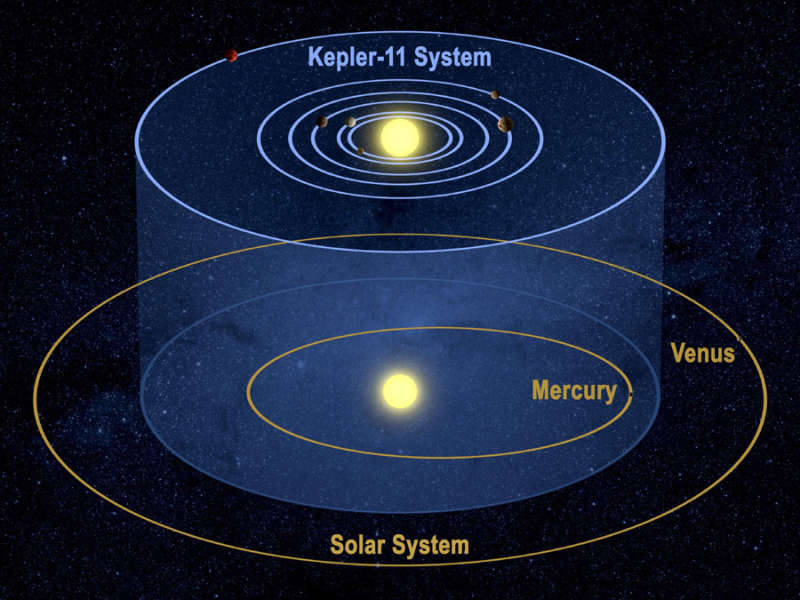Credit & Copyright: Tim Pyle, NASA
Explanation:
Six worlds orbit Kepler-11,
a sunlike star 2,000 light-years
distant in the constellation Cygnus.
The new discovery, based on data from NASA's
planet hunting Kepler spacecraft,
makes the Kepler-11 system
the fullest exoplanetary system known.
Compared to our Solar System in this illustration,
five of Kepler-11's planets orbit closer to their parent star than the
Mercury-Sun distance, with
orbital periods ranging from 10 to 47 days.
All six are larger than Earth and are likely composed of mixtures of
rocky material and gas.
Their presence, sizes, and masses have been determined by carefully
watching the planets dim the light of Kepler-11 while
transiting or
crossing in front of the star itself.
In fact, in August 2010, Kepler's telescope and camera
recorded a simultaneous transit of three of the planets in the system.
As announced yesterday,
using the transit technique
the Kepler mission has now identified over
1200 exoplanet candidates in a
field of view
that covers only about 1/400th of the sky.
The tantalizing result suggests there are many
undiscovered
planets orbiting the stars in
our galaxy.
1999 2000 2001 2002 2003 2004 2005 2006 2007 2008 2009 2010 2011 2012 2013 2014 2015 2016 2017 2018 2019 2020 2021 2022 2023 2024 2025 |
Yanvar' Fevral' Mart Aprel' Mai Iyun' Iyul' Avgust Sentyabr' Oktyabr' Noyabr' Dekabr' |
NASA Web Site Statements, Warnings, and Disclaimers
NASA Official: Jay Norris. Specific rights apply.
A service of: LHEA at NASA / GSFC
& Michigan Tech. U.
|
Publikacii s klyuchevymi slovami:
extrasolar planet - kepler - transit - ekzoplaneta - Kepler - zatmenie
Publikacii so slovami: extrasolar planet - kepler - transit - ekzoplaneta - Kepler - zatmenie | |
Sm. takzhe:
Vse publikacii na tu zhe temu >> | |
